.gif)
Junk (ship)
Encyclopedia

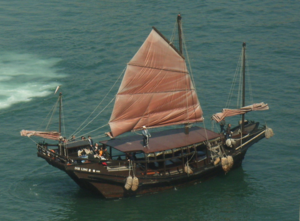
China
Chinese civilization may refer to:* China for more general discussion of the country.* Chinese culture* Greater China, the transnational community of ethnic Chinese.* History of China* Sinosphere, the area historically affected by Chinese culture...
sailing vessel design still in use today. Junks were developed during the Han Dynasty
Han Dynasty
The Han Dynasty was the second imperial dynasty of China, preceded by the Qin Dynasty and succeeded by the Three Kingdoms . It was founded by the rebel leader Liu Bang, known posthumously as Emperor Gaozu of Han. It was briefly interrupted by the Xin Dynasty of the former regent Wang Mang...
(206 BC–220 AD) and were used as sea-going vessels as early as the 2nd century AD. They evolved in the later dynasties, and were used throughout Asia
Asia
Asia is the world's largest and most populous continent, located primarily in the eastern and northern hemispheres. It covers 8.7% of the Earth's total surface area and with approximately 3.879 billion people, it hosts 60% of the world's current human population...
for extensive ocean voyages. They were found, and in lesser numbers are still found, throughout South-East Asia and India
India
India , officially the Republic of India , is a country in South Asia. It is the seventh-largest country by geographical area, the second-most populous country with over 1.2 billion people, and the most populous democracy in the world...
, but primarily in China
China
Chinese civilization may refer to:* China for more general discussion of the country.* Chinese culture* Greater China, the transnational community of ethnic Chinese.* History of China* Sinosphere, the area historically affected by Chinese culture...
, perhaps most famously in Hong Kong
Hong Kong
Hong Kong is one of two Special Administrative Regions of the People's Republic of China , the other being Macau. A city-state situated on China's south coast and enclosed by the Pearl River Delta and South China Sea, it is renowned for its expansive skyline and deep natural harbour...
. Found more broadly today is a growing number of modern recreational junk-rigged sailboats.
Etymology
Phonetic, from Chinese ("boat, ship"), (Mandarin ), also based on and pronounced as /dzuːŋ/ in the Min NanMin Nan
The Southern Min languages, or Min Nan , are a family of Chinese languages spoken in southern Fujian, eastern Guangdong, Hainan, Taiwan, and southern Zhejiang provinces of China, and by descendants of emigrants from these areas in diaspora....
dialect (閩南語), or the old word for a sailing vessel (pinyin: zhōu). It entered English in the 17th century via Portuguese junco, from Java
Java
Java is an island of Indonesia. With a population of 135 million , it is the world's most populous island, and one of the most densely populated regions in the world. It is home to 60% of Indonesia's population. The Indonesian capital city, Jakarta, is in west Java...
djong. The Chinese word for an ocean-going vessel is .
Design
Junks were efficient and sturdy shipShip
Since the end of the age of sail a ship has been any large buoyant marine vessel. Ships are generally distinguished from boats based on size and cargo or passenger capacity. Ships are used on lakes, seas, and rivers for a variety of activities, such as the transport of people or goods, fishing,...
s that sailed long distances as early as the 2nd century AD. They incorporated numerous technical advances in sail plan and hull designs that were later adopted in Western shipbuilding.
The historian H. Warington Smyth considered the junk one of the most efficient ship designs, stating that "As an engine for carrying man and his commerce upon the high and stormy seas as well as on the vast inland waterways, it is doubtful if any class of vessel… is more suited or better adapted to its purpose than the Chinese or Indian junk, and it is certain that for flatness of sail and handiness, the Chinese rig is unsurpassed."
Sail plan
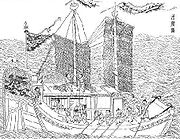
Junk Rig
The Junk rig, also known as the Chinese lugsail and Sampan rig, is a type of sail rig in which rigid members, called battens, span the full width of the sail and extend the sail forward of the mast....
make the junk easy to sail, and fast. Unlike a traditional square rig
Square rig
Square rig is a generic type of sail and rigging arrangement in which the primary driving sails are carried on horizontal spars which are perpendicular, or square, to the keel of the vessel and to the masts. These spars are called yards and their tips, beyond the last stay, are called the yardarms...
ged ship, the sails of a junk can be moved inward, toward the long axis of the ship, allowing the junk to sail into the wind.
The sails include several horizontal members, called "batten
Batten
A batten is a thin strip of solid material, typically made from wood, plastic or metal. Battens are used in building construction and various other fields as both structural and purely cosmetic elements...
s", which provide shape and strength. Junk sails are controlled at their trailing edge by lines much in the same way as the mainsail on a typical sailboat, but in the junk sail each batten has a line attached to its trailing edge where on a typical sailboat a single line (the sheet) is attached only to the boom. The sails can also be easily reefed and adjusted for fullness, to accommodate various wind strengths. The battens also make the sails more resistant than traditional sails to large tears, as a tear is typically limited to a single "panel" between battens. Junk sails have much in common with the most aerodynamically efficient sails used today in windsurfers or catamaran
Catamaran
A catamaran is a type of multihulled boat or ship consisting of two hulls, or vakas, joined by some structure, the most basic being a frame, formed of akas...
s.
The standing rigging
Rigging
Rigging is the apparatus through which the force of the wind is used to propel sailboats and sailing ships forward. This includes masts, yards, sails, and cordage.-Terms and classifications:...
is simple or absent.
The sail-plan
Sail-plan
A sail-plan is a set of drawings, usually prepared by a naval architect. It shows the various combinations of sail proposed for a sailing ship.The combinations shown in a sail-plan almost always include three configurations:...
is also spread out between multiple masts, allowing for a powerful sail surface, and a good repartition of efforts. The rig allows for good sailing into the wind.
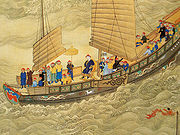
Hull design
Classic junks were built of softwoodSoftwood
The term softwood is used to describe wood from trees that are known as gymnosperms.Conifers are an example. It may also be used to describe trees, which tend to be evergreen, notable exceptions being bald cypress and the larches....
s (although of teak
Teak
Teak is the common name for the tropical hardwood tree species Tectona grandis and its wood products. Tectona grandis is native to south and southeast Asia, mainly India, Indonesia, Malaysia, and Burma, but is naturalized and cultivated in many countries, including those in Africa and the...
in Guangdong
Guangdong
Guangdong is a province on the South China Sea coast of the People's Republic of China. The province was previously often written with the alternative English name Kwangtung Province...
) with multiple compartments accessed by separate hatches and ladders, reminiscent of the interior structure of bamboo. Traditionally, the hull has a horseshoe-shaped stern supporting a high poop deck
Poop deck
In naval architecture, a poop deck is a deck that forms the roof of a cabin built in the rear, or "aft", part of the superstructure of a ship.The name originates from the French word for stern, la poupe, from Latin puppis...
. The bottom is flat with no keel (similar to a sampan
Sampan
A sampan is a relatively flat bottomed Chinese wooden boat from long. Some sampans include a small shelter on board, and may be used as a permanent habitation on inland waters. Sampans are generally used for transportation in coastal areas or rivers, and are often used as traditional fishing boats...
), so that the boat relies on a daggerboard
Daggerboard
A daggerboard is a retractable centreboard used by various sailing craft. While other types of centreboard may pivot to retract, a daggerboard slides in a casing. The shape of the daggerboard converts the forward motion into a windward lift, countering the leeward push of the...
, leeboard
Leeboard
A leeboard is a lifting foil used by a sailboat, much like a centerboard, but located on the leeward side of the boat. The leeward side is used so that the leeboard isn't lifted from the water when the boat heels, or leans under the force of the wind....
or very large rudder to prevent the boat from slipping sideways in the water. The largest junks, the treasure ship
Treasure ship
A Treasure ship is the name for a type of large wooden vessel commanded by the Chinese admiral Zheng He on seven voyages in the early 15th century in Ming Dynasty...
s commanded by Zheng He
Zheng He
Zheng He , also known as Ma Sanbao and Hajji Mahmud Shamsuddin was a Hui-Chinese mariner, explorer, diplomat and fleet admiral, who commanded voyages to Southeast Asia, South Asia, the Middle East, and East Africa, collectively referred to as the Voyages of Zheng He or Voyages of Cheng Ho from...
, were built for world exploration in the 15th century, and according to some interpretations may have been over 120 metres (393.7 ft) in length.
Rudders
Junks employed stern-mounted rudders centuries before their adoption in the West, though the rudder's origin, form and construction was completely different. It was an innovation which permitted the steering of large, high-freeboardFreeboard (nautical)
In sailing and boating, freeboardmeans the distance from the waterline to the upper deck level, measured at the lowest point of sheer where water can enter the boat or ship...
ships, and, due to its well-balanced design, allowed adjustment according to the depth of the water. A sizable junk can have a rudder that needs up to three members of the crew to control in strong weather. The world's oldest known depiction of a stern-mounted rudder can be seen on a pottery model of a junk dating from before 1st century AD, though some scholars think this may be a steering oar - a possible interpretation given that the model is of a river boat that was probably towed or poled.
From sometime in the 13th-15th centuries, many junks began incorporating "fenestrated" rudders (rudders with holes in them), probably adopted to lessen the force needed to direct the steering of the rudder.
The rudder is reported to be the strongest part of the junk. In the Tiangong Kaiwu "Exploitation of the Works of Nature" (1637), Song Yingxing
Song Yingxing
Song Yingxing , born in Yichun of Jiangxi, was a Chinese scientist and encyclopedist who lived during the late Ming Dynasty . He was the author of an encyclopedia that covered a wide variety of technical subjects, including the use of gunpowder weapons...
wrote, "The rudder-post is made of elm, or else of langmu or of zhumu." The Ming author also applauds the strength of the langmu wood as "if one could use a single silk thread to hoist a thousand jun or sustain the weight of a mountain landslide."
Separate compartments
Another characteristic of junks, interior compartments or bulkheadsBulkhead (partition)
A bulkhead is an upright wall within the hull of a ship or within the fuselage of an airplane. Other kinds of partition elements within a ship are decks and deckheads.-Etymology:...
, strengthened the ship and slowed flooding
Ship floodability
Floodability is a characteristic of the construction of a ship to resist flooding.Floodability is achieved by dividing the volume of the hull into watertight compartments with decks and bulkheads , use of double bottom, and by other means.Watertight bulkhead compartments were written of by the Song...
in case of holing. Ships built in this manner were written of in Zhu Yu's
Zhu Yu (author)
Zhu Yu was an author of the Chinese Song Dynasty . He retired in Huang Gang of the Hubei province, bought a country house and named it "Pingzhou". He called himself "Expert Vegetable Grower of Pingzhou ". Between 1111 and 1117 AD, Zhu Yu wrote the book Pingzhou Ketan , published in 1119 AD...
book Pingzhou Table Talks, published by 1119 AD during the Song Dynasty
Song Dynasty
The Song Dynasty was a ruling dynasty in China between 960 and 1279; it succeeded the Five Dynasties and Ten Kingdoms Period, and was followed by the Yuan Dynasty. It was the first government in world history to issue banknotes or paper money, and the first Chinese government to establish a...
. Again, this type of construction for Chinese ship hulls was attested to by the Moroccan Muslim Berber
Berber people
Berbers are the indigenous peoples of North Africa west of the Nile Valley. They are continuously distributed from the Atlantic to the Siwa oasis, in Egypt, and from the Mediterranean to the Niger River. Historically they spoke the Berber language or varieties of it, which together form a branch...
traveler Ibn Batutta (1304-1377 AD), who described it in great detail (refer to Technology of the Song Dynasty
Technology of the Song Dynasty
The Song Dynasty provided some of the most significant technological advances in Chinese history, many of which came from talented statesmen drafted by the government through imperial examinations....
). Although some historians have questioned whether the compartments were watertight, most believe that watertight compartments
Bulkhead (partition)
A bulkhead is an upright wall within the hull of a ship or within the fuselage of an airplane. Other kinds of partition elements within a ship are decks and deckheads.-Etymology:...
did exist in Chinese junks. All wrecks discovered so far have limber hole
Limber hole
A limber hole is a drain hole through a frame in a boat designed to prevent water from accumulating against one side of the frame. Limber holes are common in the bilges of wooden boats. The term may be extended to cover drain holes in floors.-References:...
s; these are different from the free flooding holes that are located only in the foremost and aftermost compartments, but are at the base of the transverse bulkheads allowing water in each compartment to drain to the lowest compartment, thus facilitating pumping. It is believed from evidence in wrecks that the limber holes could be stopped either to allow the carriage of liquid cargoes or to isolate a compartment that had sprung a leak.
Benjamin Franklin
Benjamin Franklin
Dr. Benjamin Franklin was one of the Founding Fathers of the United States. A noted polymath, Franklin was a leading author, printer, political theorist, politician, postmaster, scientist, musician, inventor, satirist, civic activist, statesman, and diplomat...
wrote in a 1787 letter on the project of mail packets between the United States and France:
In 1795, Sir Samuel Bentham
Samuel Bentham
Sir Samuel Bentham was a noted English mechanical engineer and naval architect credited with numerous innovations, particularly related to naval architecture, including weapons...
, inspector of dockyards of the Royal Navy
Royal Navy
The Royal Navy is the naval warfare service branch of the British Armed Forces. Founded in the 16th century, it is the oldest service branch and is known as the Senior Service...
, and designer of six new sailing ships, argued for the adoption of "partitions contributing to strength, and securing the ship against foundering, as practiced by the Chinese of the present day". His idea was not adopted. Bentham had been in China in 1782, and he acknowledged that he had got the idea of watertight compartments by looking at Chinese junks there. Bentham was a friend of Isambard Brunel
Isambard Kingdom Brunel
Isambard Kingdom Brunel, FRS , was a British civil engineer who built bridges and dockyards including the construction of the first major British railway, the Great Western Railway; a series of steamships, including the first propeller-driven transatlantic steamship; and numerous important bridges...
, so it is possible that he had some influence on Brunel's adoption of longitudinal, strengthening bulkheads in the lower deck of the SS Great Britain
SS Great Britain
SS Great Britain was an advanced passenger steamship designed by Isambard Kingdom Brunel for the Great Western Steamship Company's transatlantic service between Bristol and New York. While other ships had previously been built of iron or equipped with a screw propeller, Great Britain was the first...
. Bentham had already by this time designed and had built a segmented barge for use on the Volga River, so the idea of transverse hull separation was evidently in his mind. Perhaps more to the point, there is a very large difference between the transverse bulkheads in Chinese construction, which offer no longitudinal strengthening, and the longitudinal members which Brunel adopted, almost certainly inspired by the bridge engineering in which he and his contemporaries in iron shipbuilding innovation were most versed.
Due to the numerous foreign primary sources that hint to the existence of true watertight compartments in junks, historians such as Joseph Needham
Joseph Needham
Noel Joseph Terence Montgomery Needham, CH, FRS, FBA , also known as Li Yuese , was a British scientist, historian and sinologist known for his scientific research and writing on the history of Chinese science. He was elected a fellow of the Royal Society in 1941, and as a fellow of the British...
proposed that the limber holes were stopped up as noted above in case of leakage. He addresses the quite separate issue of free-flooding compartments on pg 422 of Science and Civilisation in Ancient China:
Leeboards & centerboards
LeeboardLeeboard
A leeboard is a lifting foil used by a sailboat, much like a centerboard, but located on the leeward side of the boat. The leeward side is used so that the leeboard isn't lifted from the water when the boat heels, or leans under the force of the wind....
s and centerboards, used to stabilize the junk and to improve its capability to sail upwind, are documented from a 759 AD book by Li Chuan. The innovation was adopted by Portuguese and Dutch ships around 1570. Junks often employ a daggerboard that is forward on the hull which allows the center section of the hull to be free of the daggerboard trunk allowing larger cargo compartments. Because the daggerboard is located so far forward, the junk must use a balanced rudder
Balanced rudder
The balanced rudder was an innovation in warship construction used as early as 1862 in the USS Monitor, one of the Union's first ironclads during the American Civil War...
to counteract the imbalance of lateral resistance.
Other innovations included the square-pallet bilge pump
Bilge pump
A bilge pump is a water pump used to remove bilge water. Since fuel can be present in the bilge, electric bilge pumps are designed to not cause sparks. Electric bilge pumps are often fitted with float switches which turn on the pump when the bilge fills to a set level. Since bilge pumps can fail,...
, which was adopted by the West during the 16th century for work ashore, the western chain pump, which was adopted for shipboard use, being of a different derivation. Junks also relied on the compass
Compass
A compass is a navigational instrument that shows directions in a frame of reference that is stationary relative to the surface of the earth. The frame of reference defines the four cardinal directions – north, south, east, and west. Intermediate directions are also defined...
for navigational purposes. However, as with almost all vessels of any culture before the late 19th century, the accuracy of magnetic compasses aboard ship, whether from a failure to understand deviation (the magnetism of the ship's iron fastenings) or poor design of the compass card (the standard drypoint compasses were extremely unstable), meant that they did little to contribute to the accuracy of navigation by dead reckoning.
History
The first records of junks can be found in references dating to the Han DynastyHan Dynasty
The Han Dynasty was the second imperial dynasty of China, preceded by the Qin Dynasty and succeeded by the Three Kingdoms . It was founded by the rebel leader Liu Bang, known posthumously as Emperor Gaozu of Han. It was briefly interrupted by the Xin Dynasty of the former regent Wang Mang...
(220 BC-200 AD).
2nd century junks (Han Dynasty)
The 3rd century book "Strange Things of the South" (南州異物志) by Wan Chen (萬震) describes junks capable of carrying 700 people together with 260 tons of cargo ("more than 10,000 "斛"). He explains the ship's design as follows:A 260 AD book by Kang Tai (康泰) also described ships with seven masts, traveling as far as Syria
Syria
Syria , officially the Syrian Arab Republic , is a country in Western Asia, bordering Lebanon and the Mediterranean Sea to the West, Turkey to the north, Iraq to the east, Jordan to the south, and Israel to the southwest....
.

10–13th century junks (Song Dynasty)
The great trading dynasty of the SongSong Dynasty
The Song Dynasty was a ruling dynasty in China between 960 and 1279; it succeeded the Five Dynasties and Ten Kingdoms Period, and was followed by the Yuan Dynasty. It was the first government in world history to issue banknotes or paper money, and the first Chinese government to establish a...
employed junks extensively. The naval strength of the Song, both mercantile and military, became the backbone of the naval power of the following Yuan dynasty. In particular the Mongol invasions of Japan
Mongol invasions of Japan
The ' of 1274 and 1281 were major military efforts undertaken by Kublai Khan to conquer the Japanese islands after the submission of Goryeo to vassaldom. Despite their ultimate failure, the invasion attempts are of macrohistorical importance, because they set a limit on Mongol expansion, and rank...
(1274–84), as well as the Mongol invasion of Java
Mongol invasion of Java
In 1293, Kublai Khan, the Great Khan of the Mongol Empire and the founder of the Yuan Dynasty, sent a large invasion fleet to Java with 20,000 to 30,000 soldiers...
, essentially relied on recently acquired Song naval capabilities.
14th century junks (Yuan Dynasty)
.jpg)
Marco Polo
Marco Polo was a Venetian merchant traveler from the Venetian Republic whose travels are recorded in Il Milione, a book which did much to introduce Europeans to Central Asia and China. He learned about trading whilst his father and uncle, Niccolò and Maffeo, travelled through Asia and apparently...
, Ibn Battuta
Ibn Battuta
Abu Abdullah Muhammad Ibn Battuta , or simply Ibn Battuta, also known as Shams ad–Din , was a Muslim Moroccan Berber explorer, known for his extensive travels published in the Rihla...
and Niccolò da Conti
Niccolò Da Conti
Niccolò de' Conti was an Italian merchant and explorer of the Republic of Venice, born in Chioggia, who traveled to India and Southeast Asia, and possibly to Southern China, during the early 15th century...
. According to Ibn Battuta, who visited China in 1347:
Expedition of Zheng He
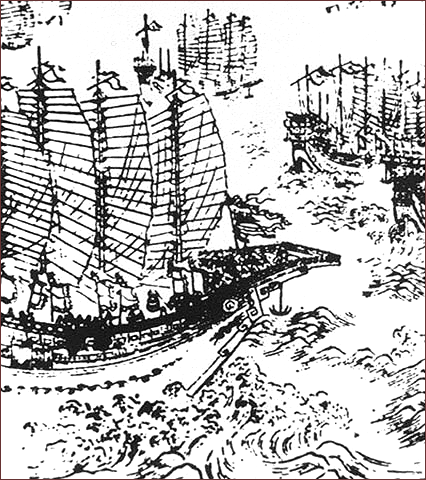
Zheng He
Zheng He , also known as Ma Sanbao and Hajji Mahmud Shamsuddin was a Hui-Chinese mariner, explorer, diplomat and fleet admiral, who commanded voyages to Southeast Asia, South Asia, the Middle East, and East Africa, collectively referred to as the Voyages of Zheng He or Voyages of Cheng Ho from...
, for his expeditions in the Indian Ocean
Indian Ocean
The Indian Ocean is the third largest of the world's oceanic divisions, covering approximately 20% of the water on the Earth's surface. It is bounded on the north by the Indian Subcontinent and Arabian Peninsula ; on the west by eastern Africa; on the east by Indochina, the Sunda Islands, and...
. According to Chinese sources, the fleet for Zheng's 1405 expedition comprised nearly 30,000 sailors and over 300 ships at its height.
The dimensions of Zheng He's ships according to ancient Chinese chronicles are disputed by modern scholars (see below):
- Treasure shipTreasure shipA Treasure ship is the name for a type of large wooden vessel commanded by the Chinese admiral Zheng He on seven voyages in the early 15th century in Ming Dynasty...
s, used by the commander of the fleet and his deputies (Nine-masted junks, claimed by the Ming Shi to be about 420 feet long and 180 feet wide). - Horse ships, carrying tribute goods and repair material for the fleet (Eight-masted junks, about 340 feet long and 140 feet wide)
- Supply ships, containing food-staple for the crew (Seven-masted junks, about 260 feet long and 115 feet wide).
- Troop transports (Six-masted junks, about 220 feet long and 83 feet wide).
- Fuchuan warships (Five-masted junks, about 165 feet long).
- Patrol boats (Eight-oared, about 120 feet long).
- Water tankers, with 1 month's supply of fresh water.
Some recent research suggests that the actual length of the biggest treasure ships may have been between 390–408 ft (118.9–124.4 m) long and 160–166 ft (48.8–50.6 m) wide, while others estimate them to be 200–250 ft (61–76.2 m) in length.
Conquest of Taiwan
In 1661, a naval fleet of 400 junks and 25,000 men led by the Ming loyalist Zheng Chenggong (Cheng Ch'eng-kung in Wade-GilesWade-Giles
Wade–Giles , sometimes abbreviated Wade, is a romanization system for the Mandarin Chinese language. It developed from a system produced by Thomas Wade during the mid-19th century , and was given completed form with Herbert Giles' Chinese–English dictionary of 1892.Wade–Giles was the most...
, known in the West as Koxinga
Koxinga
Koxinga is the customary Western spelling of the popular appellation of Zheng Chenggong , a military leader who was born in 1624 in Hirado, Japan to Zheng Zhilong, a Chinese merchant/pirate, and his Japanese wife and died in 1662 on the island of Formosa .A Ming loyalist and the arch commander of...
), arrived in Taiwan
Taiwan
Taiwan , also known, especially in the past, as Formosa , is the largest island of the same-named island group of East Asia in the western Pacific Ocean and located off the southeastern coast of mainland China. The island forms over 99% of the current territory of the Republic of China following...
to oust the Dutch
Netherlands
The Netherlands is a constituent country of the Kingdom of the Netherlands, located mainly in North-West Europe and with several islands in the Caribbean. Mainland Netherlands borders the North Sea to the north and west, Belgium to the south, and Germany to the east, and shares maritime borders...
from Zeelandia
Fort Zeelandia (Taiwan)
Fort Zeelandia was a fortress built over ten years from 1624–1634 by the Dutch Verenigde Oostindische Compagnie, in the town of Anping on the island of Formosa, present day Taiwan, during their 38-year rule over the western part of it...
. Following a nine month siege, Cheng captured the Dutch fortress Fort Zeelandia
Fort Zeelandia (Taiwan)
Fort Zeelandia was a fortress built over ten years from 1624–1634 by the Dutch Verenigde Oostindische Compagnie, in the town of Anping on the island of Formosa, present day Taiwan, during their 38-year rule over the western part of it...
. A peace treaty between Koxinga and the Dutch Government was signed at Castle Zeelandia on February 1st 1662, and Taiwan
Taiwan
Taiwan , also known, especially in the past, as Formosa , is the largest island of the same-named island group of East Asia in the western Pacific Ocean and located off the southeastern coast of mainland China. The island forms over 99% of the current territory of the Republic of China following...
became Koxinga's base for the Kingdom of Tungning
Kingdom of Tungning
The Kingdom of Tungning was a government that ruled Taiwan between 1661 and 1683. A pro-Ming Dynasty state, it was founded by Koxinga after the Ming government in mainland China was replaced by the Manchu-ruled Qing Dynasty...
.
Accounts of medieval travellers
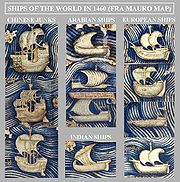
Niccolò Da Conti
Niccolò de' Conti was an Italian merchant and explorer of the Republic of Venice, born in Chioggia, who traveled to India and Southeast Asia, and possibly to Southern China, during the early 15th century...
in his relations of his travels in Asia between 1419 and 1444, matter-of-factly describes huge junks of about 2,000 tons:
Also, in 1456, the Fra Mauro map
Fra Mauro map
The Fra Mauro map, "considered the greatest memorial of medieval cartography" according to Roberto Almagià, is a map made around 1450 by the Venetian monk Fra Mauro...
described the presence of junks in the Indian Ocean as well as their construction:

Cape of Good Hope
The Cape of Good Hope is a rocky headland on the Atlantic coast of the Cape Peninsula, South Africa.There is a misconception that the Cape of Good Hope is the southern tip of Africa, because it was once believed to be the dividing point between the Atlantic and Indian Oceans. In fact, the...
and travelled far into the Atlantic Ocean
Atlantic Ocean
The Atlantic Ocean is the second-largest of the world's oceanic divisions. With a total area of about , it covers approximately 20% of the Earth's surface and about 26% of its water surface area...
, in 1420:
Asian trade
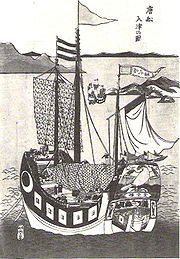
Red seal ships
were Japanese armed merchant sailing ships bound for Southeast Asian ports with a red-sealed patent issued by the early Tokugawa shogunate in the first half of the 17th century...
, Portuguese carrack
Carrack
A carrack or nau was a three- or four-masted sailing ship developed in 15th century Western Europe for use in the Atlantic Ocean. It had a high rounded stern with large aftcastle, forecastle and bowsprit at the stem. It was first used by the Portuguese , and later by the Spanish, to explore and...
s and Dutch galleons. Richard Cocks
Richard Cocks
Richard Cocks was the head of the British East India Company trading post in Hirado, Japan, between 1613 and 1623, from its creation, and lasting to its closure due to bankruptcy....
, the head of the English trading factory in Hirado, Japan, recorded that 50 to 60 Chinese junks visited Nagasaki in 1612 alone.
These junks were usually three masted, and averaging between 200 and 800 tons in size, the largest ones having around 130 sailors, 130 traders and sometimes hundreds of passengers.
19th century junks (Qing Dynasty)

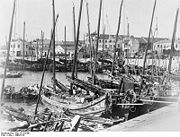
Junk Keying
Keying was a three-masted, 800-ton Foochow Chinese trading junk which sailed from China around the Cape of Good Hope to the United States and Britain between 1846 and 1848....
, sailed from China around the Cape of Good Hope
Cape of Good Hope
The Cape of Good Hope is a rocky headland on the Atlantic coast of the Cape Peninsula, South Africa.There is a misconception that the Cape of Good Hope is the southern tip of Africa, because it was once believed to be the dividing point between the Atlantic and Indian Oceans. In fact, the...
to the United States and England between 1846 and 1848. Many junks were fitted out with carronades and other weapons for naval or piratical uses. These vessels were typically called "war junks" or "armed junks" by Western navies which began entering the region more frequently in the 18th century. The British, Americans and French fought several naval battles with war junks in the 19th century, during the First Opium War
First Opium War
The First Anglo-Chinese War , known popularly as the First Opium War or simply the Opium War, was fought between the United Kingdom and the Qing Dynasty of China over their conflicting viewpoints on diplomatic relations, trade, and the administration of justice...
, Second Opium War
Second Opium War
The Second Opium War, the Second Anglo-Chinese War, the Second China War, the Arrow War, or the Anglo-French expedition to China, was a war pitting the British Empire and the Second French Empire against the Qing Dynasty of China, lasting from 1856 to 1860...
and in between
Battle of Kuhlan
The Battle of Ty-ho Bay was a significant naval engagement in 1855 involving the British Royal Navy, the United States Navy and Chinese pirates. The action off Tai O, Hong Kong was to rescue captured merchant vessels, held by a fleet of armed war-junks. British and American forces defeated the...
.
20th century junks
In 1938, E. Allen Petersen escaped the advancing Japanese armies by sailing a 36 feet (11 m) junk, Hummel Hummel, from Shanghai to California with his wife Tani and two White Russians (Czar loyalists). In 1939, Richard HalliburtonRichard Halliburton
Richard Halliburton was an American traveler, adventurer, and author. Best known today for having swum the length of the Panama Canal and paying the lowest toll in its history—thirty-six cents—Halliburton was headline news for most of his brief career...
was lost at sea with his crew while sailing a specially constructed junk, Sea Dragon, from Hong Kong to the World Exposition in San Francisco.
In 1955, six young men sailed a Ming Dynasty
Ming Dynasty
The Ming Dynasty, also Empire of the Great Ming, was the ruling dynasty of China from 1368 to 1644, following the collapse of the Mongol-led Yuan Dynasty. The Ming, "one of the greatest eras of orderly government and social stability in human history", was the last dynasty in China ruled by ethnic...
-style junk from Taiwan
Taiwan
Taiwan , also known, especially in the past, as Formosa , is the largest island of the same-named island group of East Asia in the western Pacific Ocean and located off the southeastern coast of mainland China. The island forms over 99% of the current territory of the Republic of China following...
to San Francisco. The four-month journey aboard the Free China was captured on film and their arrival into San Francisco made international front-page news. The five Chinese-born friends saw an advertisement for an international trans-Atlantic yacht race, and jumped at the opportunity for adventure. They were joined by the then US Vice-Consul to China, who was tasked with capturing the journey on film. Enduring typhoons and mishaps, the crew, having never sailed a century-old junk before, learned along the way. The crew included Reno Chen, Paul Chow, Loo-chi Hu, Benny Hsu, Calvin Mehlert and were led by skipper Marco Chung. After a journey of 6000 miles (9,656 km), the Free China and her crew arrived into San Francisco Bay under a majestic fog on August 8, 1955. Shortly afterward the footage was featured on ABC television's Bold Journey travelogue. Hosted by John Stephenson and narrated by ship's navigator Paul Chow, the program highlighted the adventures and challenges of the junk's sailing across the Pacific, as well as some humorous moments aboard ship.
In 1959 a group of Catalan
Catalonia
Catalonia is an autonomous community in northeastern Spain, with the official status of a "nationality" of Spain. Catalonia comprises four provinces: Barcelona, Girona, Lleida, and Tarragona. Its capital and largest city is Barcelona. Catalonia covers an area of 32,114 km² and has an...
men, led by Jose Maria Tey, sailed from Hong Kong
Hong Kong
Hong Kong is one of two Special Administrative Regions of the People's Republic of China , the other being Macau. A city-state situated on China's south coast and enclosed by the Pearl River Delta and South China Sea, it is renowned for its expansive skyline and deep natural harbour...
to Barcelona
Barcelona
Barcelona is the second largest city in Spain after Madrid, and the capital of Catalonia, with a population of 1,621,537 within its administrative limits on a land area of...
on a junk named Rubia. After their successful journey this junk was anchored as a tourist attraction at one end of Barcelona harbor, close to where La Rambla
La Rambla
La Rambla is a street in central Barcelona, popular with both tourists and locals alike. A 1.2 kilometer-long tree-lined pedestrian mall between Barri Gòtic and El Raval, it connects Plaça de Catalunya in the centre with the Christopher Columbus monument at Port Vell.- Overview :La Rambla can be...
meets the sea. Permanently moored along with it was an alleged reproduction of Columbus' caravel "Santa Maria" during the 1960s and part of the 1970s.
In 1960 Lt. Col. Herbert George "Blondie" Hasler, (Herbert Hasler
Herbert Hasler
Lieutenant-Colonel Herbert George "Blondie" Hasler, DSO, OBE was a distinguished Royal Marines officer in World War II, responsible for many of the concepts which ultimately led to the post-war formation of the Special Boat Service...
), DSO, OBE, (27 February 1914 – 5 May 1987) sailed in the first Observer Single-handed Transatlantic Race (OSTAR) from Plymouth to New York. His yacht was a modified Folkboat, called Jester, which at 25 feet (7.6 m) , was one of the smallest boats in the race.
The Jester relied on a junk rig
Junk Rig
The Junk rig, also known as the Chinese lugsail and Sampan rig, is a type of sail rig in which rigid members, called battens, span the full width of the sail and extend the sail forward of the mast....
to reduce the physical effort of handling a conventional rig single-handed. Safety was also increased as the junk rig enabled all sail-handling to be completed from the safety of a central control hatch. Hasler realised that he could sail Jester across the Atlantic without ever leaving the cabin. Hasler in Jester finished second, taking 48 days to cross the Atlantic.
In 1968, Bill King sailed a junk schooner in the controversial Sunday Times Golden Globe Race
Sunday Times Golden Globe Race
The Sunday Times Golden Globe Race was a non-stop, single-handed, round-the-world yacht race, held in 1968–1969, and was the first round-the-world yacht race...
.
A growing number of designs of modern recreational junk-rigged sailboats has emerged, such as Benford Design Group's Badger known from Annie Hill
Annie Hill
Annie Hill is an English sailor, author of books and articles about sailboat voyaging, living on a small amount of money and sailing junk rigs.-Biography:...
's book Voyaging on a Small Income. Tom MacNaughton of MacNaughton Group also has several popular junk rigged designs.
For long travels with few crew, the simplicity of the junk rig in terms of construction, maintenance and handling makes it an important alternative to more prevalent designs. Most notably the safety that follows from extremely simple reefing, which is particularly important with few crew and deteriorating conditions, minimizes the need to work on deck while exposed to bad weather. Simple construction means lower cost and simpler repairs.
External links
- World of Boats (EISCA) Collection ~ Keying II Hong Kong Junk
- China Seas Voyaging Society
- The Free China, homepage of one of the last remaining 20th century junks, with video.
- The Junk and Advanced Cruising Rig Association, The JRA

